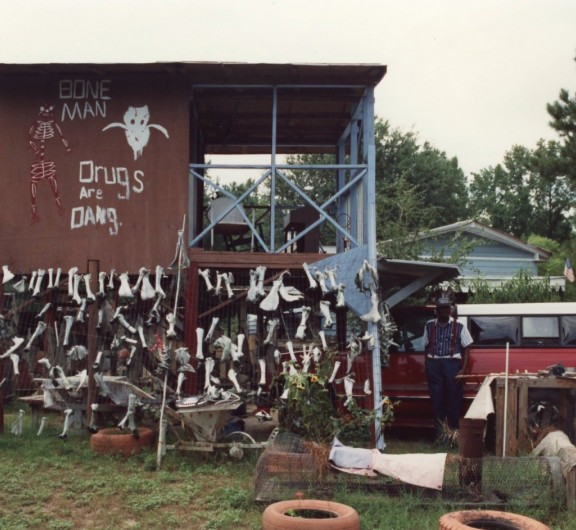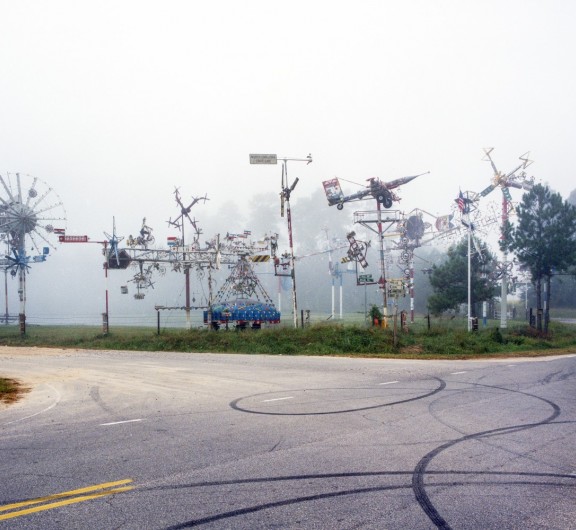Minnie Evans Bottle ChapelVirginia Wright-Frierson
About the Artist/Site
The Airlie Gardens are a 67-acre site that was part of an original land grant given by English King George II to the Ogden brothers in 1736; it changed hands numerous times over the centuries, but even under private ownership, the owners would typically open the gardens to the public several times a year, particularly, during the late 19th and early 20th centuries, to see the 25,000 azaleas in full bloom. In 1998, however, the area was in decline, reeling from damage from recent hurricanes, and the owners were approached with an offer to convert the estate to a subdivision with 47 single-family homes. The County Commissioners, however, felt that the site should remain accessible to the public, so working with the local land trust and the owners, the County purchased the property. In addition to restoring the numerous gardens, ten acres of ponds, and a historic oak that dates from 1545, they added a variety of public programs, including concerts and events such as an Oyster Roast and holiday light shows, to increase visitor attendance and enjoyment.
Renowned artist Minnie Evans (1892-1987) had moved with her mother to Wilmington when she was one year old; her mother married a man who worked for Pembroke Jones, a wealthy industrialist whose wife, Sarah Green Jones, ultimately established Airlie Gardens, turning them into one of the South’s most famous showcase gardens. By age 17, Evans began working as a domestic for the Jones family, and from 1948 to 1974 worked as gatekeeper for the estate gardens (developed by Sarah Green Jones after the death of her second husband, Henry Walters). There she collected admission and sold her artwork, hanging her pieces on the front gate. Her work displays clear influences of the Gardens: “God has some 600 shades of green,” she once said, “and He dressed the world with them.” Evans had her first formal exhibition at the Artists’ Gallery in Wilmington in 1961.
Evans and her artwork became so linked to Airlie Gardens that in 2004, artist Wright-Frierson and seven other local artists and one gardener created a bottle house-like “chapel” to honor her. Over 5,000 recycled bottles of all shapes, sizes, and colors are layered between chicken wire forms and concrete mortar. Situated in the middle of a raised circular platform, the construction is not a “house” per se, but rather a luminous open-air sanctuary whose side wings are linked with bronze branch-like forms. Shell fragments, pieces of broken pottery, and other found objects are also inset into the mortar. The images on the bottle walls include flowering trees and celestial bodies, but also reference some of Evans’ imagery, including her elaborately decorative faces. These images formed by the bottle bottoms are best seen from the exterior, as the necks protrude into the interior. In the center of the enclosure, which is ringed with mosaic-topped benches supported by low bottle walls, is a bronze sculpture of trees and birds. 95 tiles created in conjunction with local schoolchildren commemorate each year of Evans’ life; four benches are adorned with symbols found in Evans’ work; and a fountain carved with images from her paintings also honor Evans’ link to the site.
The Minnie Evans Bottle Chapel is viewable whenever the Airlie Gardens are open to the public. A small entrance fee is charged.
~Jo Farb Hernández
Map & Site Information
300 Airlie Road
Wilmington, North Carolina, 28403
us
Latitude/Longitude: 34.2143013 / -77.8243988
Extant
300 Airlie Road, Wilmington, North Carolina, 28403, United States
The Minnie Evans Bottle Chapel is viewable whenever the Airlie Gardens are open to the public. A small entrance fee is charged.
Nearby Environments









Post your comment
Comments
No one has commented on this page yet.